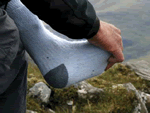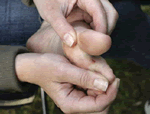Blisters are painful, fluid-filled lesions, often caused by friction and pressure. The most common cause is repeated rubbing from Ill-fitting footwear and socks, and excessive moisture between the foot and the sock. Blisters can also be caused by Foot deformities, and be of concern to those with exisiting conditions such as Diabetes. If you suffer from one of these conditions please refer to your podiatrist for advice.
How to Prevent Blisters
As blisters are a result of friction there are a number of simple techniques that can prevent your walking, running or social activity being ruined by a blister:
- Wear comfortable, good-fitting footwear especially on long walks or runs.
- Wear good walking socks in the right size, look for ones made of fibres with good ‘wicking’ properties. Try wearing socks inside out to prevent the seams rubbing. Change your socks daily!
- Some walkers and runners wear special ‘dual layer’ socks. The inner layer moves with the foot, the outer with the shoe - eliminating friction at the skin surface. Ensure you change to a fresh pair after they become damp.
- Keep your toenails trim
- If your feet get very sweaty there are products that can help control excessive moisture. Your podiatrist can tell you about these.
- Quickly remove any foreign bodies from your socks and boots
- Ensure that the tongue and laces of your boots are arranged correctly and evenly
- Check your feet carefully and regularly for any sign of rubbing and tenderness
 If you feel a blister developing do this:
If you feel a blister developing do this:
Act immediately you feel any friction or discomfort: blisters can form very quickly. If you feel a blister developing, stop walking, take your boots and socks off and examine your feet. Consider applying some material cushioning or padding, or a breathable waterproof plaster.
If a blister has developed
 Most foot blisters filled with clear fluid last between three and seven days, and will normally clear up if further excessive friction is avoided. If a blister does occur, do not pop it. Cut a hole in a piece of foam or felt, forming a ‘doughnut’ over the blister; tape the foam or felt in place or cover with a soft geltype dressing. Treat an open blister with mild soap and water; cover it with an anti-septic ointment and protective soft gel dressing to prevent infection and speed up the healing process.
Most foot blisters filled with clear fluid last between three and seven days, and will normally clear up if further excessive friction is avoided. If a blister does occur, do not pop it. Cut a hole in a piece of foam or felt, forming a ‘doughnut’ over the blister; tape the foam or felt in place or cover with a soft geltype dressing. Treat an open blister with mild soap and water; cover it with an anti-septic ointment and protective soft gel dressing to prevent infection and speed up the healing process.
What can a podiatrist do?
A podiatrist can explain how to reduce the risk and cure foot blisters, advise on their treatment and check that your feet are generally in good condition. Podiatrists can also provide expert advice on the use of insoles (also known as orthotics) and other appliances to keep your feet healthy and comfortable.

